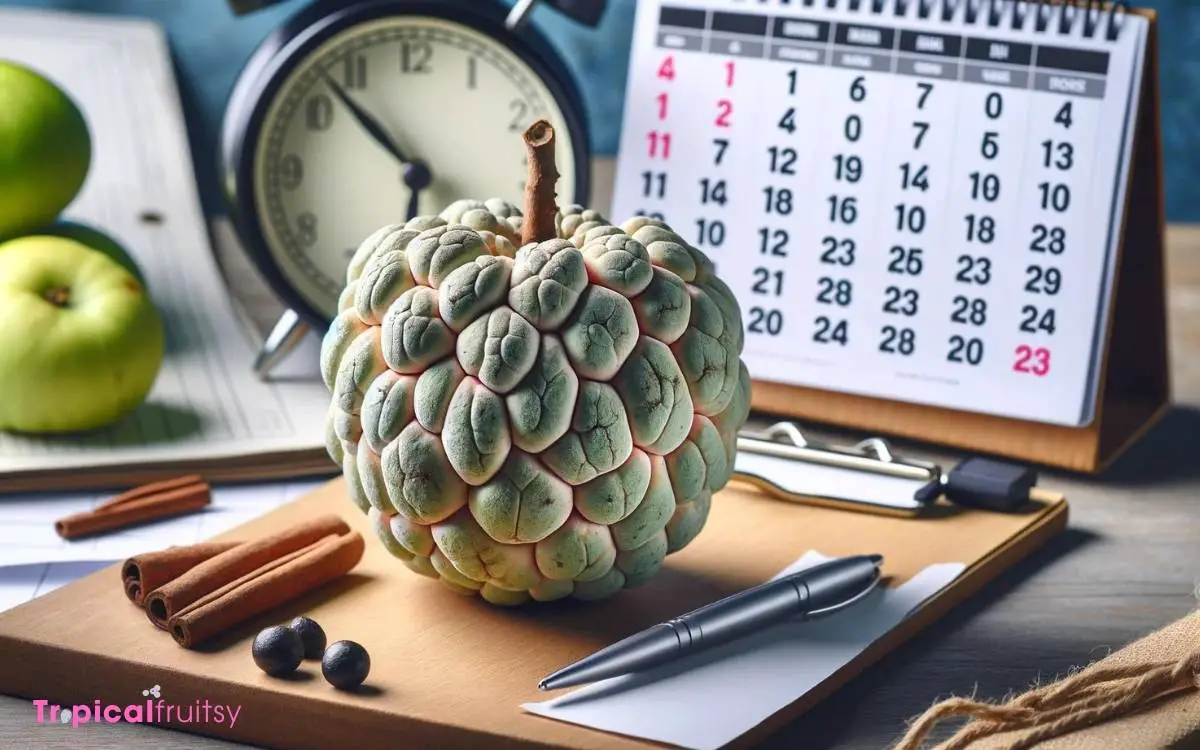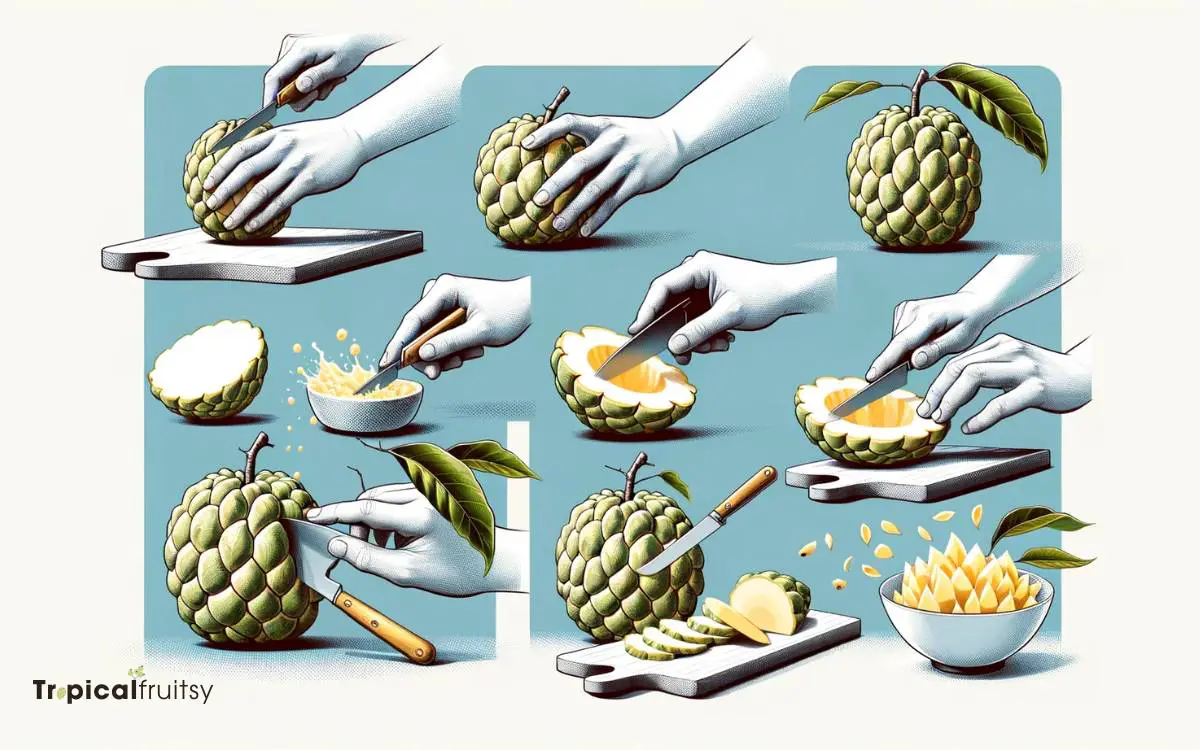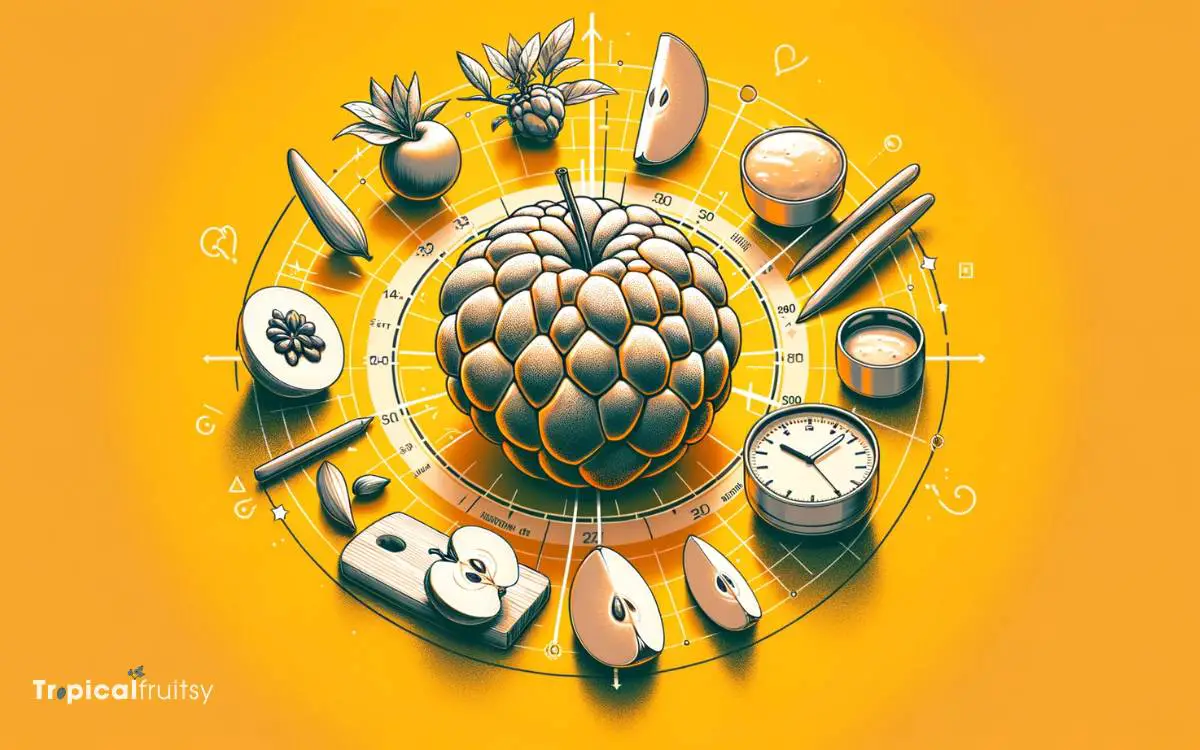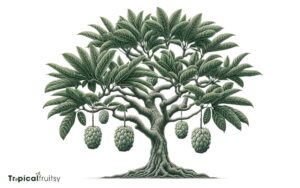Custard Apple When to Eat: Explained!
It feels like I’ve waited an eternity for the custard apple season to roll around, but knowing exactly when to indulge in this creamy, tropical fruit can be just as important as the wait itself.
I’ve learned that the best time to eat a custard apple is when it’s just reached peak ripeness, which typically occurs shortly after they soften to a gentle squeeze.
I make sure to keep an eye on the skin, as it transitions from a vibrant green to a more muted, yellow-green hue, signaling it’s ready to be savored.
If I jump the gun and it’s too firm, I’ll miss out on the full sweetness, and if I’m too late, the flesh might become overly mushy and ferment.
So, I patiently monitor my custard apples, ensuring I get that perfect blend of sugary, custard-like flavor and buttery texture every time.

Key Takeaway
Understanding Custard Apple Seasonality

I’ve zeroed in on the seasonality of custard apples to pinpoint the best time to enjoy this sweet, tropical fruit.
Typically, custard apples are in season from late summer through early winter, which can vary based on your location. In some tropical regions, the fruit may be available year-round.
However, for the freshest and most flavorful experience, it’s essential to look for them during their peak season.
You should note that the fruit’s ripeness is key. A ripe custard apple will be slightly soft to the touch and may have a fragrant aroma.
If you’re buying them out of season, they mightn’t only be more expensive but also lack the optimal taste and texture that make custard apples so delightful.
Identifying Peak Ripeness

After learning about custard apple seasonality, I’ll now guide you through how to identify when the fruit has reached peak ripeness. It’s crucial to enjoy custard apples at just the right time for the best flavor and texture.
Here’s a concise table to help you spot the signs of a perfectly ripe custard apple:
| Feature | Underripe | Perfectly Ripe |
|---|---|---|
| Color | Greenish | Darker, green-brown |
| Texture | Firm | Slightly soft |
| Skin | Intact, unyielding | Yields to gentle pressure |
| Aroma | Mild or absent | Sweet, pronounced |
| Stem | Tightly attached | Comes off easily |
When you find a custard apple that matches the ‘Perfectly Ripe’ column, it’s ready to be savored!
Harvesting and Storage Tips

Knowing the best time to pick custard apples is crucial for enjoying their optimal flavor. I’ll guide you through the signs of ripeness to look for, ensuring you harvest at the right moment.
We’ll also cover how to store your custard apples to maximize their shelf life after picking.
Optimal Picking Time
I’ll guide you through identifying the perfect moment to harvest custard apples, ensuring they’re at their peak for consumption.
Generally, the optimal picking time is when the fruit has fully grown in size and the skin starts to turn from green to a lighter color, often yellowish. It’s crucial not to wait too long as overripe fruits may fall and spoil.
For storage, keep unripe custard apples at room temperature until they soften. Once ripe, you can refrigerate them to prolong freshness, but consume within a few days for best taste. Careful handling is essential because they bruise easily.
Ripeness Indicators
Firmness gives me a clear indicator of a custard apple’s ripeness, signaling when it’s time to pluck it from the tree and how to store it for optimal flavor.
When I gently squeeze the fruit, a ripe custard apple will yield slightly under pressure, indicating it’s ready for harvest.
I also look for a change in color, from a vibrant green to a light green or yellowish hue. Once picked, I store custard apples at room temperature if they’re not quite ripe, which allows them to soften further.
If they’re already ripe, I put them in the fridge to slow down the ripening process. This helps me enjoy them at their peak taste and texture, ensuring I don’t miss out on their creamy, tropical flavor.
Longevity in Storage
After harvesting, I’ve found that custard apples can be kept for up to three weeks when stored properly in a cool, dark place. It’s crucial to handle them gently to avoid bruising, which can lead to premature spoilage.
To maintain freshness, I avoid washing the fruits until I’m ready to eat them, as moisture can encourage decay.
Here’s a quick table to break down the essentials:
| Storage Condition | Expected Shelf Life |
|---|---|
| Room temperature | 5-7 days |
| Refrigerator | 2-3 weeks |
| Freezer (pulp) | 3-6 months |
While refrigeration extends their life significantly, freezing the pulp is an option if I’m looking to keep it longer. However, I’ve found that freezing can alter the texture, so it’s best used for smoothies or baking.
Signs of Overripe Fruit

In recognizing when a custard apple has passed its prime, I look for certain telltale signs of overripeness.
Here’s what stands out:
- Softness: When the fruit yields too much to gentle pressure, it’s often beyond its best stage for consumption.
- Skin Discoloration: Dark spots or a widespread browning can indicate that the custard apple has started to spoil.
- Off-putting Odor: A sour or fermented smell is a clear sign that the fruit is overripe and potentially unsuitable for eating.
- Leakage: Any oozing or the presence of excess liquid around the custard apple suggests that it’s time to discard the fruit.
It’s important to use these indicators to avoid the unpleasant texture and taste of an overripe custard apple.
Preparing Custard Apples for Consumption

Before I enjoy a custard apple, I look for signs of ripeness, such as a slight give under pressure and a sweet aroma.
I’ve found that the best cutting technique is to slice the fruit in half, which exposes the creamy flesh and makes seed removal easier.
It’s important to handle the seeds with care, as they’re not edible, and I make sure to discard them before indulging in the sweet, custard-like fruit.
Ripeness Indicators
To determine the perfect time for eating a custard apple, I look for several key signs of ripeness that ensure the fruit’s flesh is sweet and creamy.
- The skin color changes from a vibrant green to a lighter, yellowish hue, indicating the fruit is getting ripe.
- The fruit yields slightly to gentle pressure, similar to how a ripe avocado would feel.
- A sweet, fragrant aroma emanates from the custard apple, which becomes more pronounced as it ripens.
- The stem detaches easily without much effort, which is a clear sign that the custard apple is ready to be enjoyed.
Understanding these indicators helps me enjoy custard apples at their peak flavor.
Cutting Technique
I’ve found that the best way to cut into a custard apple is to slice it in half, starting at the stem.
This approach lets you see the creamy interior and makes it easier to remove the seeds. You’ll want to use a sharp knife to make a clean cut; a dull blade can squash the fruit and make a mess.
Once it’s halved, you can scoop out the flesh with a spoon, much like you’d with an avocado. Be careful to avoid the seeds, as they’re not edible.
If you’re preparing it for a dish or presentation, you can make further slices into quarters for a more manageable size. Always work on a stable cutting board to ensure safety and precision.
Seed Removal Tips
After halving the custard apple, I use a spoon to gently scoop out the seeds, ensuring the sweet flesh is ready for enjoyment.
Here’s how I make sure it’s done efficiently:
- Cut the fruit into halves or quarters to expose the seed-filled interior.
- Use a spoon to gently pry the seeds from the flesh, taking care not to crush them as some seeds may be bitter.
- Discard the seeds properly, away from the eating area to avoid any accidental ingestion.
- Check for any hidden seeds that might’ve been missed during the initial scooping to ensure every bite is seed-free and delightful.
This straightforward approach maximizes the amount of edible fruit while keeping the experience pleasant.
Best Times for Eating

I find that the best time to eat a custard apple is when it’s fully ripe, usually when the skin gives slightly to a gentle press. The fruit should feel soft, indicating the flesh inside is creamy and ready for consumption.
Eating it at this stage maximizes the natural sweetness and texture. It’s also easier to digest because the sugars are fully developed.
Avoid fruit with over-soft spots or blemishes, as these may be signs of overripeness or decay, which can negatively affect both flavor and nutritional value.
Nutritionally, a ripe custard apple is rich in vitamins and minerals. Enjoying it as a snack or dessert is ideal.
Custard Apple Health Benefits
Enjoying a ripe custard apple not only satisfies the taste buds but also delivers a host of health benefits, including a rich supply of vitamins, minerals, and dietary fiber.
Here’s a breakdown of the advantages:
- Vitamin C Content: Custard apples are packed with vitamin C, which is essential for immune system support and skin health.
- Antioxidant Power: These fruits contain antioxidants that combat free radicals, potentially reducing the risk of chronic diseases.
- Dietary Fiber: A high fiber content aids in digestion and can help manage weight by promoting a feeling of fullness.
- Mineral Richness: Custard apples provide important minerals like magnesium and potassium, which support heart health and muscle function.
Incorporating custard apples into your diet isn’t just a treat for your palate; it’s a smart choice for maintaining overall health.
What are the best times to eat custard apple?
The best times for eating custard apple steps vary depending on individual preferences. Some enjoy it as a refreshing breakfast option, while others indulge in it as a dessert after lunch or dinner. Regardless of the chosen time, custard apple steps provide a delectable treat packed with vitamins and minerals.
Pairing With Other Foods

One can enhance their culinary experience by combining custard apple with complementary foods that balance its creamy texture and sweet flavor.
Here’s a handy table to guide you:
| Food Category | Pairing Ideas | Reason for Pairing |
|---|---|---|
| Dairy | Yogurt, Ice Cream | Adds richness, complements creaminess |
| Nuts & Seeds | Almonds, Chia Seeds | Crunchy texture, nutritional boost |
| Grains | Oatmeal, Rice Pudding | Neutral base, highlights fruit’s sweetness |
| Herbs & Spices | Cinnamon, Nutmeg | Enhances flavor, adds warmth |
| Beverages | Milkshakes, Smoothies | Blends well, creates refreshing treats |
I find that custard apple’s unique flavor pairs wonderfully with these foods, creating a delightful taste experience.
Whether you’re looking to spruce up your breakfast or craft an indulgent dessert, these pairings are both practical and delicious.
Preserving for Off-Season Enjoyment

Preservation is key to savoring custard apple’s sweetness even when it’s not in season.
Here’s how I make sure I can enjoy this delightful fruit year-round:
- Freezing: I peel the custard apples, deseed them, and cut the flesh into chunks. Then, I lay them on a baking sheet to freeze individually before transferring to an airtight container.
- Canning: Making custard apple jam or preserves is a great option. I cook the flesh with sugar and pectin, and then can it using a water bath method.
- Dehydrating: I slice the fruit thinly and dehydrate it at a low temperature until it’s completely dry. This makes for a chewy, sweet snack.
- Pureeing: I puree the fruit and freeze it in ice cube trays. It’s perfect for smoothies or as a natural sweetener.
Conclusion
Diving into the world of custard apples is like discovering a treasure trove of creamy, dreamy delights. I’ve found that when you nail the timing, these fruits can unlock a universe of flavor and health perks.
By mastering the art of spotting that perfect ripeness and knowing how to store them, you’ll ensure every bite is a heavenly experience.
So, don’t hesitate to indulge in this luscious gem when nature signals it’s showtime!






